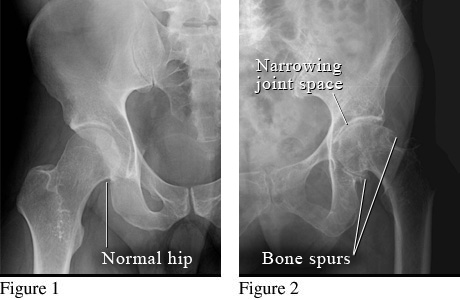What is hip arthritis?
Arthritis is a breakdown of the tissue (cartilage) that cushions your joints. It can cause pain and stiffness. Hip arthritis happens when the cartilage in your hip joint wears down. This can cause your hipbone to rub against the hip socket.
What are the symptoms of hip arthritis?
The symptoms include pain and stiffness in the hip joint. The pain may be felt deep in the front of the groin. Hip arthritis can make it harder to bend or get the full range of motion you used to have. Symptoms can be mild to severe.
X-Ray of Osteoarthritis of the Hip

Courtesy of Intermountain Medical Imaging, Boise, Idaho
Figure 1 shows a normal hip.
Figure 2 shows osteoarthritis of the hip with loss of cartilage, narrowing of the joint space (the space between the bones), and bone spurs.
How can you care for yourself when you have hip arthritis?
- Stay at a healthy weight. Being overweight puts extra strain on your hip joints.
- Talk to your doctor or physical therapist about exercises that will help ease hip pain. These tips may help.
- Stretch to help prevent stiffness and to prevent injury before you exercise. You may enjoy gentle forms of yoga to help keep your joints and muscles flexible.
- Walk instead of jog. Other types of exercise that are less stressful on the joints include riding a bike, swimming, and doing water exercise.
- Lift weights. Strong muscles help reduce stress on your joints. Stronger thigh muscles, for example, take some of the stress off of the knees and hips. Learn the right way to lift weights so you do not make joint pain worse.
- Take pain medicines exactly as directed.
- If the doctor gave you a prescription medicine for pain, take it as prescribed.
- If you are not taking a prescription pain medicine, ask your doctor if you can take an over-the-counter medicine.
- Use a cane, crutch, walker, or another device if you need help to get around. These can help rest your hips. You also can use other things to make life easier, such as a higher toilet seat.
- Do not sit in low chairs, which can make it painful to get up.
- Put heat or cold on your sore hips as needed. Use whichever helps you most. You also can go back and forth between hot and cold packs.
- Apply heat 2 or 3 times a day for 20 to 30 minutes—using a heating pad, hot shower, or hot pack—to relieve pain and stiffness.
- Put ice or a cold pack on your sore hips for 10 to 20 minutes at a time to numb the area. Put a thin cloth between the ice and your skin.
- Think about talking to your doctor about using capsaicin, a cream you apply to the skin for pain relief.
Hip arthritis: When to call
Call your doctor now or seek immediate medical care if:
- You have sudden swelling, warmth, or pain in any joint.
- You have joint pain and a fever or rash.
- You have such bad pain that you cannot use the joint.
Watch closely for changes in your health, and be sure to contact your doctor if:
- You have mild joint symptoms that continue even with more than 6 weeks of care at home.
- You do not get better as expected.
- You have stomach pain or other problems with your medicine.
©2011-2026 Healthwise, Incorporated
